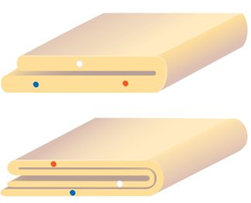
Making dough. Many delicious French desserts, such as Napoleons, are made of numerous thin layers of pastry. Once upon a time a French chef began, as usual, to make a masterpiece with a segment of dough one unit long. This time, however, he noticed that three grains of colored sugar-one red, one white, and one blue-were embedded in the pastry. He stretched the dough to twice its length and then folded it in half to produce a double layer of thinner pastry still one unit long. He again stretched the dough to double its length and, folded it to produce four layers again one unit long. He repeated, the process: stretch to twice its length, fold to produce eight layers. He stretched and folded again and again. As our chef stretched and folded, he became fascinated with the movement of those three grains of sugar. In fact, he noticed that the red grain always returned to its original location. The white grain began somewhere, went to a different location after a stretch and fold, and then returned to its original location after one more stretch and fold. The blue grain rotated among three different places. The chef was so fascinated with the infinitely recurring itineraries of these grains of sugar that he stretched and folded the dough to such an extreme thinness that his dessert creation lived up to the high expectations for light, puffy French desserts and became the Napoleon of pastries.

Want to see the full answer?
Check out a sample textbook solution
Chapter 7 Solutions
The Heart of Mathematics: An Invitation to Effective Thinking, WileyPLUS NextGen Card with Loose-leaf Set Single Semester: An Invitation to Effective Thinking (Key Curriculum Press)
Additional Math Textbook Solutions
Intro Stats, Books a la Carte Edition (5th Edition)
Basic Business Statistics, Student Value Edition
Precalculus
Elementary Statistics
Elementary Statistics (13th Edition)
STATISTICS F/BUSINESS+ECONOMICS-TEXT
- please give the answerarrow_forwardNeed help with the following statistic problems.arrow_forwardom nearest tenth if necessary. milsum 3. છે. 9.3mm 3mm A 78-43-92 4-3) 11.7 of 72.04-11.7-= lygons 7.8 mi 60.94 blants" 9 om 6. 4.15-7 16- 32m 1.8m 4.5m % ose 4.5m as to 65m 14 represents 5 square meters.arrow_forward
- After a great deal of experimentation, two college senior physics majors determined that when a bottle of French champagne is shaken several times, held upright, and uncorked, its cork travels according to the function below, where s is its height (in feet) above the ground t seconds after being released. s(t)=-16t² + 30t+3 a. How high will it go? b. How long is it in the air?arrow_forward2PM Tue Mar 4 7 Dashboard Calendar To Do Notifications Inbox File Details a 25/SP-CIT-105-02 Statics for Technicians Q-7 Determine the resultant of the load system shown. Locate where the resultant intersects grade with respect to point A at the base of the structure. 40 N/m 2 m 1.5 m 50 N 100 N/m Fig.- Problem-7 4 m Gradearrow_forwardif δ ≥ 2, then it contains a cycle with length at least δ + 1.arrow_forward
 Elementary Geometry For College Students, 7eGeometryISBN:9781337614085Author:Alexander, Daniel C.; Koeberlein, Geralyn M.Publisher:Cengage,
Elementary Geometry For College Students, 7eGeometryISBN:9781337614085Author:Alexander, Daniel C.; Koeberlein, Geralyn M.Publisher:Cengage, Mathematics For Machine TechnologyAdvanced MathISBN:9781337798310Author:Peterson, John.Publisher:Cengage Learning,
Mathematics For Machine TechnologyAdvanced MathISBN:9781337798310Author:Peterson, John.Publisher:Cengage Learning, Elementary Geometry for College StudentsGeometryISBN:9781285195698Author:Daniel C. Alexander, Geralyn M. KoeberleinPublisher:Cengage Learning
Elementary Geometry for College StudentsGeometryISBN:9781285195698Author:Daniel C. Alexander, Geralyn M. KoeberleinPublisher:Cengage Learning


